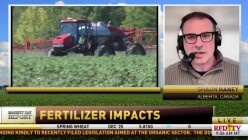Imports
American Farm Bureau Federation (AFBF) economist Danny Munch joined us on Thursday’s Market Day Report to break down the scope of the U.S. Christmas Tree industry and what growers are up against.
Mold damage is tightening China’s corn supplies, supporting higher prices and creating potential demand for alternative feed grains in early 2026.
Texas livestock producers face a heightened biosecurity threat as New World screwworm detections in northern Mexico coincide with FDA approval of the first topical treatment.
Buying a real Christmas tree directly supports U.S. farmers facing rising import competition, long production cycles, and weather-driven risks.
Tyson’s capacity cuts weaken local basis, tighten kill space, and heighten dependence on imports, signaling more volatility for producers.
Higher rail tariffs and tighter Canadian supplies will keep oat transportation costs firm into 2026.
Lower U.S. and Mexican production means tighter sugar supplies and greater reliance on imports headed into 2026.
Removing the 40% duty sharply lowers U.S. beef import costs on beef, coffee, fertilizer and fruit, and restores Brazil’s competitiveness during a period of tight domestic supply.
Only properly documented, unexhausted fertilizer applied by prior owners may qualify for Section 180 expensing; broader nutrient-based claims carry significant legal and tax risk.
Urea and phosphate see the biggest price relief from tariff exemptions, but nitrogen markets remain tight, and spring demand will still dictate pricing momentum.
Firm live cow prices and shifting dairy-side culling suggest cull cow values may stay stronger than usual this winter despite weaker cow beef cutout trends.
Tariff relief may soften grocery prices, but it also intensifies competition for U.S. fruit, vegetable, and beef producers as cheaper imports regain market share.
USDA released the November WASDE Report on Friday, the first supply-and-demand estimate to drop since September, just before the 43-day government shutdown.
U.S. Trade officials announced new deals with El Salvador, Guatemala, Ecuador, and Argentina, as well as a steep reduction in tariffs on Swiss imports.
The request follows pressure from the American Sheep Industry Association (ASIA), which called for a formal investigation into whether lamb imports from Australia and New Zealand have cut into the U.S. market share.
Stagger buys and diversifies fertilizer sources — watch CBAM, India’s tenders, and Brazil’s import pace to time urea, phosphate, and potash purchases.
Recognizing phosphorus and potash as critical minerals underscores their importance in crop production and food security, providing producers with an added layer of risk protection.
Global nitrogen and phosphate prices remain high despite improved supply fundamentals, with limited Chinese exports and stronger fall applications tightening availability.
The Sheinbaum–Rollins meeting signals progress, but the focus remains on fully containing screwworm before cross-border movement resumes.
An import lag for ground beef will likely look different than last year’s egg shortage. The difference comes down to biosecurity and market flexibility.
America’s love for burgers depends on open markets. Without lean beef imports, prices would skyrocket, crushing demand and destabilizing the beef industry.























